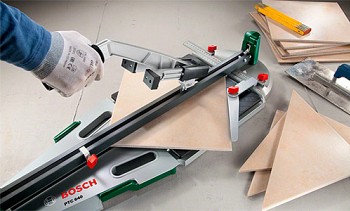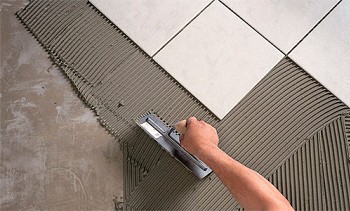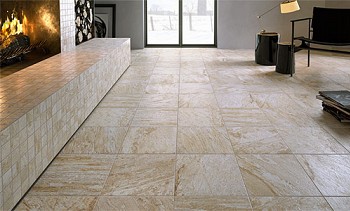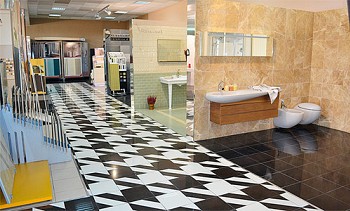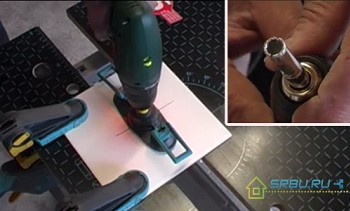Porcelain tile is one of the most practical and aesthetically attractive finishing materials. Initially, it was used exclusively for technical purposes - in public places and at industrial enterprises. However, modern technology has allowed the creation of new types of tiles, in which the outstanding characteristics and properties of porcelain tiles are combined with a variety of design options and a rich palette of textures and shades. This article describes in detail the advantages, varieties and scope of the material.
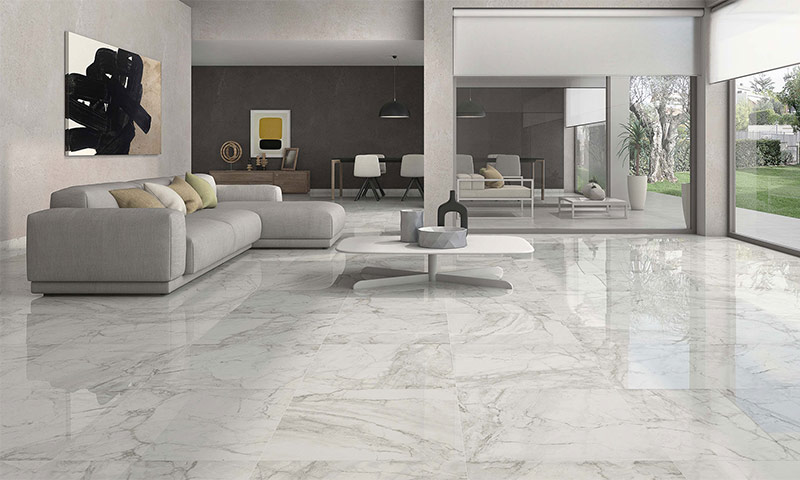
Content:
- Manufacturing technology and composition of porcelain stoneware
- Hardness and strength of porcelain stoneware
- Coefficient of friction (slippage) of ceramic granite
- Water absorption of porcelain tile
- The effect of chemically active substances on granite
- Resistance of ceramic granite to a change in appearance
- Resistance to pollution
- Tile geometry
- Variety of Porcelain Tiles
- Scopes of porcelain tile
Manufacturing technology and composition of porcelain stoneware
The basis for creating porcelain tiles is the so-called slip - a soft, mushy porcelain mass.
The composition of the raw materials includes:
- kaolin - white clay that imparts refractoriness and good binding ability to the material;
- illite clays - are necessary for giving raw materials greater plasticity, which later turns into homogeneity and bending strength.
- quartz (quartz sand) - has high strength and excellent hardness;
- feldspar - characterized by its hardness and high resistance to various chemicals;
From the slip according to a certain technology, a press powder is obtained, which is an absolutely homogeneous substance. Further, the production of granite is carried out in several stages:
- the introduction of a mixture of mineral dyes (in the manufacture of colored tiles);
- molding tiles from powder, followed by pressing and drying under pressure up to 500 kg / cm2 to remove air and excess moisture;
- drawing, glazing (if necessary);
- firing tiles in furnaces at a temperature of 1200-1300 degrees.
- grinding or polishing tiles (if necessary).
This technology allows you to get porcelain with a special structure - absolutely dense and smooth, monolithic, in which cracks, pores and foreign inclusions are almost completely absent.

Hardness and strength of porcelain stoneware
One of the most important advantages of porcelain stoneware is its exceptional hardness and increased strength. The hardness of the material on the Mohs scale used to determine the characteristics of minerals is estimated at 7-8 points. This indicator is only slightly less than that of corundum and diamond. Surfaces lined with porcelain stoneware for a long time retain their original impeccable appearance, since it does not form chips, scratches and holes. The material is extremely resistant to shock and constant loads, and therefore it becomes the optimal solution for flooring in rooms with high traffic - both people and special equipment.
The degree of strength of ceramic granite is evaluated according to two parameters - the thickness of the tile and its structure. The minimum allowable thickness of porcelain stoneware - 8 - 8.5 mm - this tile is most often used for wall decoration in rooms.

Thickness 12 - 20 mm is recognized as optimal for facing floors in rooms with high traffic. Thickened porcelain stoneware (up to 30 mm) is able to withstand heavy weight and severe shock loads, which allows it to be used to create flooring in public places.

To finally make sure the strength of porcelain tiles, it is advisable to study their reverse side. Quality elements are distinguished by very small indentations of a square shape and maximum surface uniformity, without any friability and voids - only in this case absolute reliability of the material during installation is possible.
Abrasion Resistance
Wear resistance is another essential property of porcelain stoneware. To assess the degree of abrasion of the tiles, special tests are carried out with a special abrasive roller made of corundum exposed to the surface of the material. After a certain number of cycles, the tile is illuminated with a special lamp for scuffs, and a certain class is assigned to the material.
The abrasion resistance of porcelain is graded according to the PEI scale and is as follows:

PEI I (assigned when there are no signs of abrasion after 150 revolutions of the roller) - this material is used in rooms with minimal traffic and optimal indicators of temperature and humidity, most often for dining rooms and bathrooms in houses and apartments.

PEI II (after 600 revolutions of the roller) - suitable for facing floors and walls in the bathroom, in the kitchen, loggia or balcony.

PEI III (1500 cycles of abrasion) - used for halls, hallways and verandas of private cottages, as well as for flooring in small offices.

PEI IV (over 1500 cycles of abrasion) - the most common and versatile material. It is able to withstand a fairly high load, making it suitable for finishing offices, cottages, hotels and flights of stairs in apartment buildings.

PEI V (more than 12,000 abrasion cycles) - porcelain stoneware with maximum wear resistance. It is used to decorate stairs and halls in public institutions, shopping centers and even at railway stations and airports.
Analysis of the wear resistance of porcelain tiles is carried out exclusively on glazed tiles. On a material with a matte surface, such tests are not carried out.
Coefficient of friction (slippage) of ceramic granite
The comfort and safety of its operation directly depend on the degree of possible sliding on the surface of the tile. So, polished porcelain tiles are far from always suitable for facing staircases and rooms with increased traffic, since the risk of falling and getting injured in this case increases many times. To assess the slipperiness of a tile, several scales can be used:
#1. BCRA Method UK grade smoothness rating. Represents a scale from 0 to 1 and a unit of measure µ. If the number µ is less than 0.19, the surface of the material is very slippery, if more than 0.75, then the tile is as safe as possible. The average, normal µ value for matte tiles is between 0.4 and higher.
#2. DIN 51130 standard (Germany). It is used to evaluate the slippiness of flooring for public and industrial institutions. For the former, an indicator of R from 9 to 10 is permissible, for the latter, 11-13.
#3. DIN 51097 standard. Safety assessment of porcelain stoneware when walking on it without shoes. According to this norm, class A tiles are permissible only in dry rooms, class B tiles can be used in bathrooms and showers, and the most secure class C porcelain tiles can also be used for pool lining, including sides and underwater stairs.
Water absorption of porcelain tile
Due to the almost uniform structure of porcelain stoneware and the absence of internal voids, the material has an extremely low coefficient of water absorption, the rate of which varies from 0.01 to 0.05%. For facing materials, this value can be considered the smallest - for example, the coefficient of water absorption of ordinary ceramic tiles is 1%, granite - 0.46%, and marble - 0.11%.
Such characteristics of porcelain tile provide it with excellent moisture resistance and frost resistance.The material is suitable for cladding rooms with high humidity, including showers and bathrooms - you can not be afraid that the tiles will fall off even with active use. On the street at low temperatures, porcelain stoneware is also reliable and does not crack - high-quality material easily survives up to 50 thawing and freezing cycles.
The effect of chemically active substances on granite
High density and homogeneous structure allow porcelain stoneware to exhibit high inertness to alkalis, acids and other chemical compounds. However, when interacting with some types of grout for joints, there is a risk that the mixture adheres too tightly to the surface of the tile - and therefore, experts prefer to clean and wash the remnants of the grout from the surface of porcelain stoneware almost immediately.
Resistance of ceramic granite to a change in appearance
Preservation of purity and color fastness is also included in the list of essential characteristics of porcelain stoneware. It has absolute heat resistance and does not fade under the bright sun. To assess the resistance of the decorative properties of the material to aggressive effects, tests are carried out in accordance with certain standards (EN 122, DIN 51094), according to the results of which a specific resistance class is assigned:
- AA - the absence of any changes in appearance.
- A - minimal surface changes.
- B - a noticeable change in the initial decorative properties of the material.
- C - a clearly noticeable deterioration of the original form.
- D - minimum resistance to external influences, a change in the aesthetic characteristics of the surface.

High-quality porcelain tiles, as a rule, have a class of AA or A. However, this is not always true for tiles with colored glaze, the colors of which can still fade a little over time.
Resistance to pollution
Due to its homogeneity, porcelain stoneware can withstand even fairly severe pollution - even unpolished matte tiles can be washed quite easily with abrasive and powdery products - the exception is polished and satin stoneware. Due to this, less dirt accumulates on the surface of the material, and the conditions for the propagation of harmful microorganisms are not created. In addition, this tile has antistatic properties and does not attract dust.
Tile geometry
Geometry is a characteristic of porcelain stoneware, which plays a key role in terms of the quality of material laying. It is based on the minimum difference in the sizes of tiles from one batch after firing. Each manufacturer's factory has its own gauge system, assigned after accurate measurement of tiles on all surfaces, but in general it varies from 0.1 to 0.7%.
So, for example, with the declared material size of 300x300 m, in one package there can be tiles with sizes of 300.5-299.5 - this will be a zero gauge, since the difference with the standard is minimal. The length and width within 300.5-301.5 will correspond to the first caliber, 301.5-302.5 to the second. Due to rectification (additional processing of ribs and faces), the caliber pitch can be reduced to 0.5 mm. When facing, it is possible to use only tiles with an adjacent caliber, otherwise the difference will be too noticeable, and high-quality laying will not work.
Variety of Porcelain Tiles
Today on sale you can find various types of porcelain stoneware, then we will consider the most popular options.
Technical
The least expensive and easiest to manufacture. It is distinguished by high strength and discreet appearance, often has a salt and pepper surface texture. Widely used for flooring in industrial halls.

Matt
Porcelain tile with unpolished surface, not subject to processing after firing. It is distinguished by practicality and high abrasion resistance.

Polished
It is obtained by removing the top layer of the tile, followed by grinding and polishing, after which the porcelain tile acquires a mirror shine. Due to its high slippage, it is mainly used for wall cladding in shopping centers, swimming pools or offices.

Lappated
Its other name is ground. It turns out as a result of grinding the surface with special abrasives to a polished state. After that, the surface of the granite is combined, with shiny and matte areas. This tile is more durable and less slippery than polished, so it is used quite widely.

Satin
A tile on which a layer of mineral salts is applied before firing. This gives the tile a soft, natural sheen with almost no slipping.

Glazed
Porcelain tile with a coating or pattern applied with colored glaze before firing. This tile has a high decorative effect and is used for interior design decoration in apartments, cottages, cafes and restaurants.

Structural
Embossed tile, the surface of which can imitate any structure - natural stone, natural wood, bamboo, mosaic. It looks very attractive and is often used in modern interiors.

Another novelty in the field of design is rustic porcelain stoneware, characterized by light aging and deliberate, naturally rough structure. The choice of such tiles today is impressively wide - Italian, Spanish, Russian and Chinese manufacturers offer both inexpensive and universal, as well as exclusive collections of porcelain tiles.
Scopes of porcelain tile
The scope of porcelain is wide enough. Today there are three main areas of use of facing material:
Decoration of public buildings
Porcelain stoneware is used for decorating and cladding floors and walls of large offices and business centers, shopping and entertainment complexes, hotels and train stations, restaurants and canteens, as well as for updating facades in order to aesthetically improve the architectural appearance of neighborhoods or streets.

Pools and sports facilities
Due to the reliability, durability and safety of porcelain stoneware, it is often used for lining pools, locker rooms and showers.

Ventilated facades
For curtain walls with integrated ventilation, porcelain stoneware is the optimal solution due to its high strength and durability.

Home Interiors
Porcelain tile from various design collections allows you to create a truly unique and practical design of the hall, bathroom, dining room, kitchen or porch.

Modern porcelain tile pleases with durability, unpretentiousness and remarkable aesthetic variety. Tile correctly selected in all respects and laid in compliance with the technology is able to delight with rich colors and incredible strength for more than a decade.

